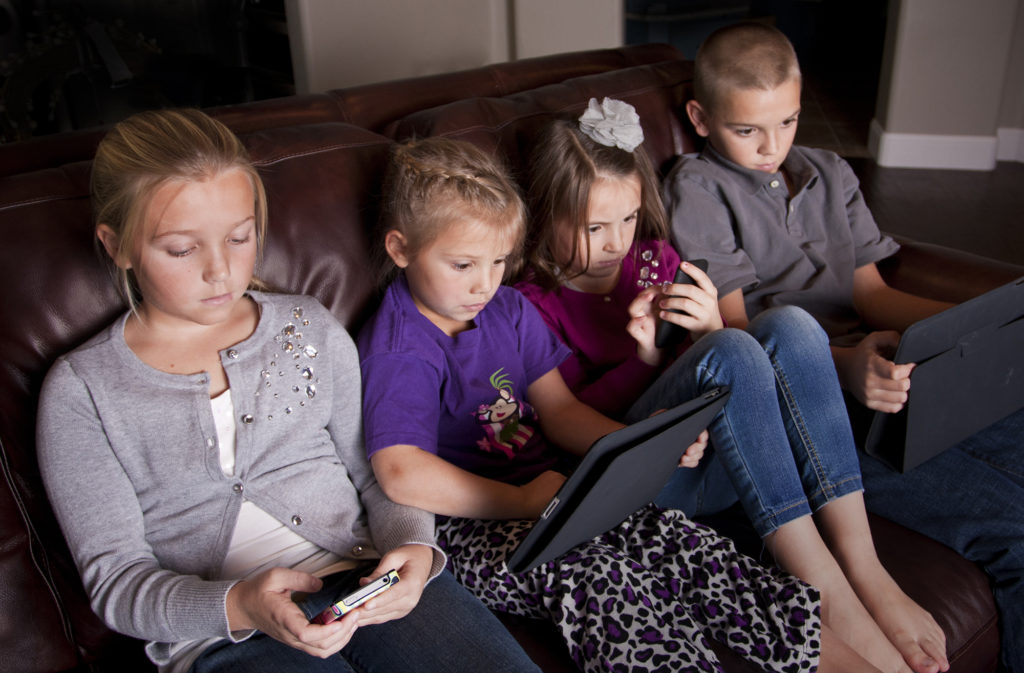With digital media ramping up so quickly and becoming a significant part of our everyday lives, there are a lot of unresolved questions about young people’s exposure to videos, TV, games and online content — as well as concerns about the potential impacts of screen time on development.
Generally speaking, parents and educators are asking “How much is too much?” and “How soon is too soon?”

Let’s start with the latter. According to the American Academy of Pediatrics, it’s best to avoid digital media for toddlers 18 to 24 months or younger. If your child is between 18 and 24 months and you decide to let them access digital media, experts recommend participating with them, because they learn from watching and talking with you.
For preschool children ages 2 to 5, the AAP encourages families to limit screen use to no more than one hour a day of high-quality programming.
“Again co-viewing is best when possible,” the association says, “and for young children they learn best when they are re-taught in the real world what they just learned through a screen. So, if Ernie just taught the letter D, you can reiterate this later when you are having dinner or spending time with your child.”
For older children, the AAP doesn’t offer a specific cap, but it does urge parents to set limits, encourage unstructured playtime and establish a family media-use plan to ensure iPads and other digital devices don’t displace important activities including family time, outdoor play, exercise, sleep and good-old-fashioned downtime.
Above all, early childhood experts underscore the importance of face-to-face communication, which is how young children learn best.
“The key is balance,” says Dareen Khatib, who oversees Student Achievement and Wellness for the Orange County Department of Education. “Learning is more meaningful, enriching and developmentally impactful when it is experienced in an interactive way, in real time, real space, with real people.
“Additionally,” she says, “we can’t forget the impact of movement and active play on the cognitive, physical, social and emotional development of children.”
And here are some additional tips to help families navigate the ever-changing digital waters, courtesy of the American Academy of Pediatrics:
Don’t use technology as an emotional pacifier.
Media can be very effective in keeping kids calm and quiet, but it shouldn’t be the only way they learn to calm down. Children need to be taught how to identify and handle strong emotions, come up with activities to manage boredom, or calm down through breathing, talking about ways to solve the problem, and finding other strategies for channeling emotions.
Treat media as you would any other environment in your child’s life.
The same parenting guidelines apply in both real and virtual environments. Set limits; kids need and expect them. Know your children’s friends, both online and off. Know what platforms, software and apps your children are using, what sites they’re visiting on the web, and what they’re doing online.
Screen time shouldn’t always be alone time.
Co-view, co-play and co-engage with your children when they are using screens — it encourages social interactions, bonding and learning. Play a video game with your kids. It’s a good way to demonstrate good sportsmanship and gaming etiquette. Watch a show with them; you will have the opportunity to introduce and share your own life experiences and perspectives and guidance. Don’t just monitor children online; interact with them. You can understand what they’re doing and be a part of it.
Be a good role model.
Teach and model kindness and good manners online. Because children are great mimics, limit your own media use. In fact, you’ll be more available for — and connected with — your children if you’re interacting, hugging and playing with them rather than simply staring at a screen.
Research apps before downloading them.
More than 80,000 apps are labeled as educational, but little research has demonstrated their actual quality. Products pitched as “interactive” should require more than “pushing and swiping.” Look to organizations like Common Sense Media for reviews about age-appropriate apps, games and programs to guide you in making the best choices for your children.
It’s OK for your teen to be online.
Online relationships are part of typical adolescent development. Social media can support teens as they explore and discover more about themselves and their place in the grown-up world. Just be sure your teen is behaving appropriately in both the real and online worlds. Many teens need to be reminded that a platform’s privacy settings do not make things actually “private,” and that images, thoughts and behaviors teens share online will instantly become a part of their digital footprint indefinitely. Keep lines of communication open and let them know you’re there if they have questions or concerns.
Warn children about the importance of privacy and the dangers of predators and sexting.
Teens need to know that once content is shared with others, they will not be able to delete or remove it completely, and that includes the texting of inappropriate pictures. They may also not know about or choose not to use privacy settings, and they need to be warned that sex offenders often use social networking, chat rooms, e-mail and online gaming to contact and exploit children.
Remember that kids will be kids.
Kids will make mistakes using media. Try to handle errors with empathy and turn a mistake into a teachable moment. But some indiscretions, such as sexting, bullying or posting self-harm images, may be a red flag that hints at trouble ahead. Parents should carefully observe their children’s behaviors and, if needed, enlist supportive professional help, including the family pediatrician.
A version of this story originally ran in January 2019.
